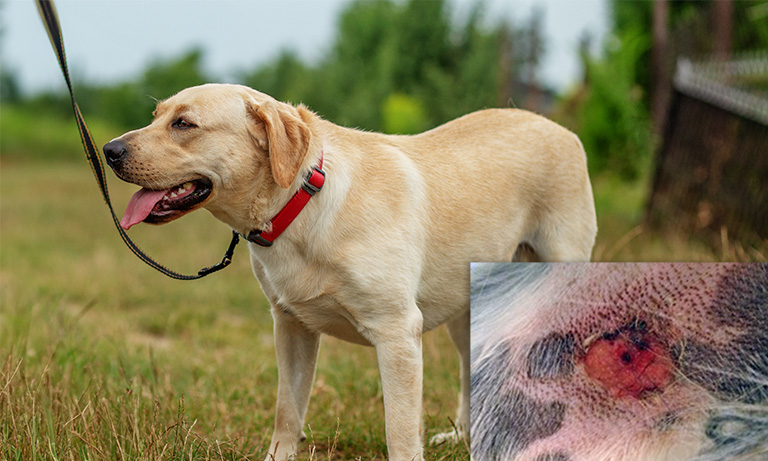Brucella canis: what vets need to know
14 Feb 2024
21 Mar 2024 | Joshua Walker
Cutaneous and Renal Glomerular Vasculopathy (CRGV), also known as Alabama Rot, is a rare but potentially fatal disease that has been identified in some dogs in the UK in the last decade. Joshua Walker, Internal Medicine Specialist at Anderson Moores Veterinary Specialists, gives an update on CRGV and what concerned dog owners need to know.

Cutaneous and renal glomerular vasculopathy (CRGV) has received a lot of media attention in recent years, so you may have heard or read about it.
It is sometimes called Alabama rot, after a disease first recognised in greyhounds in Alabama, USA in the 1980s. CRGV bears a number of similarities to Alabama Rot and is characterised by sores or lesions, usually on the bottom part of a dog’s legs. It is often associated with sudden onset kidney failure in dogs, but the cause of the disease remains under investigation.
Although concerning, it is important to stress that this disease remains rare. If your pet has a skin sore, then it is likely that this has another cause (such as an injury or infection). In the event your dog develops kidney failure independent of a skin lesion, then there could be many more common causes than CRGV.
How many dogs has CRGV affected?
Since November 2012, at least 318 cases have been confirmed on post-mortem across the UK. Currently the disease can only be definitively diagnosed after death by looking at kidney tissue under the microscope, although your vet can have a high index of suspicion for the disease on the basis of the skin lesions and some blood test changes.
A range of breeds have been identified with CRGV in the UK, though hounds (e.g Hungarian Vizsla) and gundogs appear more likely to be affected.
The location of confirmed cases can be checked online here.
There appears to be a seasonal distribution with Alabama Rot, with over 90% of cases being identified between November and May. On this basis, it is possible that there is an environmental trigger; however, this is unlikely to be the full story and it may be that certain dogs are predisposed to developing the disease. If you would like to see if any cases have been confirmed near where you live, this information is available online.
Research at the University of Bristol has had some promising early results for a potential bacteria of interest and work to confirm this is ongoing.
What are the signs of Alabama Rot?
In affected dogs, skin sores typically appear an average of three days before the development of kidney failure, although in some dogs, kidney failure can occur considerably later. The vast majority will occur within 13 days. Signs of kidney failure can include tiredness, not eating, vomiting and a change in how much water your dog drinks. Although the sores are most often on the legs, they can sometimes be seen on the body, face or within the mouth. Some dogs only get skin sores or lesions without ever getting blood test changes. Rarely, neurological problems can be seen.
If your dog is unwell (e.g., vomiting) with a new skin lesion, this would be concerning and you should take it to a vet as soon as possible.
Dogs suspected to be suffering from CRGV need intensive management at your local veterinary practice or a referral centre. Unfortunately, a large number of dogs that develop kidney failure from this disease do not survive; however, there are a number of suspected survivors (remembering the disease can only be confirmed on kidney tissue analysis, hence the use of the term suspected) and the outlook is not hopeless.
Is there anything we can do to prevent it?
It is hard to give any preventative advice that has any scientific research to support it. Some people have suggested washing dogs after a walk, particularly their feet, and this seems like a reasonable precaution.
Research into CRGV is ongoing and updates on case numbers and research will be provided on Anderson Moores Veterinary Specialists’ website.
A national charity, the Alabama Rot research fund, has also been set up to try and raise funds for research into this condition.
If you see an unexplained skin sore on your dog then the first thing to do is take your dog to your veterinary practice. Remember, the disease is rare and the sore or lesion is unlikely to be the result of CRGV.
What is the veterinary community doing to learn more about CRGV?
Research into this disease has been ongoing since 2013 and has led to a number of scientific publications.
In the UK, research into CRGV is being led by Anderson Moores Veterinary Specialists, and our team continue to actively collaborate with other centres and specialists. Identification of cases is paramount to furthering our understanding of this disease, which is why we encourage veterinary surgeons who see a suspected case to contact our specialist centre in Winchester.
Get tailored news in your inbox and online, plus access to our journals, resources and support services, join the BVA.
Join Us Today